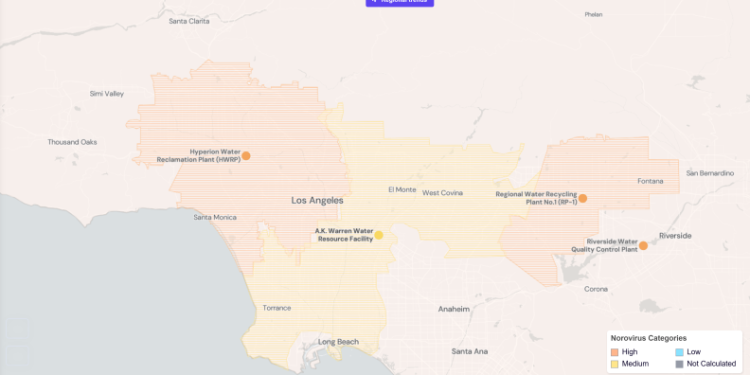If you feel like you have seen more people with stomach problems recently, you may be right. We are in the middle of the peak norovirus season.
Norovirus, nicknamed gastric flu, is a very contagious disease that can make you feel a multitude of unpleasant symptoms, such as vomiting, diarrhea and stomach cramps.
Here is what you need to know about how the virus affects southern California.
What does propagation look like?
The California intestinal flu season takes place from November to April, according to the State Health Department. Norovirus also recently received attention after The FDA has published several oyster remindersand an epidemic occurred at a Pasadena Wildfire Evacuation Center.
Dr. Elizabeth Hudson, regional chief of infectious diseases for permanent Kaiser in southern California, said that the disease spreads well in very tight areas.
“This is almost one of the main causes of all kinds of disease (gastrointestinal) in the United States, for many years,” she said.
The amount of norovirus is propagated in California can be difficult to assess. The health services only follow the reported epidemics, which the CDC defines as two or more similar diseases resulting from a common exposure.
For example, California Department of Public Health recorded 55 epidemics confirmed by the laboratory from January to November from last year, which was less than the same period in 2023.
Matt Connes, spokesperson for the department, said that the figures did not reflect the global community burden of the Norovirus because most of the cases are never tested.
With those who are, Hudson said she had seen positivity percentages increase in recent months, ranging from 10% to 25%.
“Many people do not necessarily look for care. They somehow say: “I’m going to take care of myself at home,” she said. “So I’m sure it’s probably a great underestimation.”
Recent wastewater monitoring shows a large locally important norovirus activity, which can be a more reliable means of determining propagation. The Hyperion Water Rehabilitation Factory of the City of Los Angeles reports “high” quantities of the virus, while the installation of AK WARREN water resources in the county is an “average” note.

A card that shows wastewater factories and their detected quantity of norovirus. Shading indicates the factory’s coverage area, not specific areas may have norovirus.
With kind wastewater permission
))
What to look for and do
You are the most contagious for others while you are sick. The 48 hours later, it is also when you lose the most viruses, said Hudson.
The virus lives in infected vomiting and stools, so it can spread in several ways, such as sharing bathrooms, eating contaminated foods and even touching unclean surfaces that were exposed to the virus weeks ago.
This is why it is important to consider isolate if you can, and those who take care of you wear masks and use gloves to clean. This should happen frequently with soap and water, followed by a disinfectant wipe. (Funny fact: alcohol -based disinfectants, including hand disinfectants, do not work on norovirus.)
Aside from the possibility of fever and body pain, norovirus can so ravage your gastrointestinal tract that it is difficult to keep food or liquids. The risk of dehydration is the place where a large part of the concern resides, said Hudson.
“You can become extremely dehydrated,” she said. “You may not pee so much. You may also notice when you get started to get up, you start to feel great, super dizzy. “”
These are signs that medical aid may be necessary, especially if the sick person is a child under the age of 5 or an adult over 65. However, most people can pass the disease at home.
Hudson recommends using oral rehydration salts to help you.


